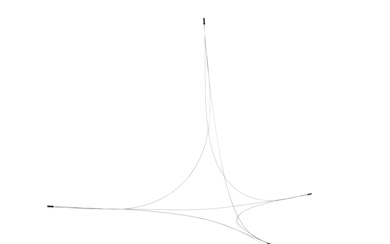Bruno Munari Model Sculpture Tempo Libero
Model sculpture Tempo Libero in plexiglass with gears and clock parts inside designed by Bruno Munari in 1995, Italy. Unique Piece. Signed.BibliographyIngannare il Tempo. Bruono Munari Archeologo. Cheating time.Bruno Munari the archaeologist. Edizioni Corraini, 2003.BiographyBruno Munari (born October 24, 1907, Milan, died September 30, 1998, Milan) was an Italian artist and graphic designer, a proponent of the Italian Futurist movement, and one of the founders of the Italian movement for concrete art, Movimento Arte Concreta (MAC) . He had a strong intellect, culture, and inclination toward the arts, which allowed him to contribute to all fields of the visual arts (painting, drawing, sculpture, Industrial and graphic design, and film), as well as literature and poetry.Bruno Munari was born in Milan but spent most of his childhood and teenage years in Badia Polesine, in the Italian region of Veneto. In 1925, at the age of 18, he returned to Milan to work with his uncle and started to follow the Futurist movement led by Filippo Tommaso Marinetti. In 1930, he worked as a graphic designer with Riccardo Castagnedi (Ricas), and from 1938 until 1943, he worked as a graphic designer for Mondadori, as well as for two of Mondatori’s magazines, Tempo Magazine and Grazia. It was during this period that Munari contributed propagandist collages to the magazines and created sculptures and his abstract-geometrical works, but it was also the time when he strengthen his love for writing and publishing.After World War II, Munari was disillusioned by Italian Futurism due to its Fascist tones and decided to disassociate himself from it, and in 1948, Munari, Gillo Dorfles, Gianni Monnet, and Atanasio Soldati founded the Movimento Arte Concreta (MAC). It is during this time, the late 1940s and 1950s, that Munari’s interest in design peaked and when he produced many light fixtures, ash trays, televisions, espresso machines, and toys, among other objects.Later in his life, Munari became increasingly interested in the design and publication of children’s books, as well as in designing toys, though he had been producing books for children since the 1930s. For his books, he often used textured and tactile surfaces, and cutouts to facilitate the teaching about touch, movement, and color through kinesthetic learning.DIMENSIONSH 9.85 in. x W 7.49 in. x D 0.79 in. / H 25 cm x W 19 cm x D 2 cm
Condition Report: Excellent
View it on
Estimate
Time, Location
Auction House
Model sculpture Tempo Libero in plexiglass with gears and clock parts inside designed by Bruno Munari in 1995, Italy. Unique Piece. Signed.BibliographyIngannare il Tempo. Bruono Munari Archeologo. Cheating time.Bruno Munari the archaeologist. Edizioni Corraini, 2003.BiographyBruno Munari (born October 24, 1907, Milan, died September 30, 1998, Milan) was an Italian artist and graphic designer, a proponent of the Italian Futurist movement, and one of the founders of the Italian movement for concrete art, Movimento Arte Concreta (MAC) . He had a strong intellect, culture, and inclination toward the arts, which allowed him to contribute to all fields of the visual arts (painting, drawing, sculpture, Industrial and graphic design, and film), as well as literature and poetry.Bruno Munari was born in Milan but spent most of his childhood and teenage years in Badia Polesine, in the Italian region of Veneto. In 1925, at the age of 18, he returned to Milan to work with his uncle and started to follow the Futurist movement led by Filippo Tommaso Marinetti. In 1930, he worked as a graphic designer with Riccardo Castagnedi (Ricas), and from 1938 until 1943, he worked as a graphic designer for Mondadori, as well as for two of Mondatori’s magazines, Tempo Magazine and Grazia. It was during this period that Munari contributed propagandist collages to the magazines and created sculptures and his abstract-geometrical works, but it was also the time when he strengthen his love for writing and publishing.After World War II, Munari was disillusioned by Italian Futurism due to its Fascist tones and decided to disassociate himself from it, and in 1948, Munari, Gillo Dorfles, Gianni Monnet, and Atanasio Soldati founded the Movimento Arte Concreta (MAC). It is during this time, the late 1940s and 1950s, that Munari’s interest in design peaked and when he produced many light fixtures, ash trays, televisions, espresso machines, and toys, among other objects.Later in his life, Munari became increasingly interested in the design and publication of children’s books, as well as in designing toys, though he had been producing books for children since the 1930s. For his books, he often used textured and tactile surfaces, and cutouts to facilitate the teaching about touch, movement, and color through kinesthetic learning.DIMENSIONSH 9.85 in. x W 7.49 in. x D 0.79 in. / H 25 cm x W 19 cm x D 2 cm
Condition Report: Excellent
Estimate
Time, Location
Auction House
Similar Items

BRUNO MUNARI Italy Login



